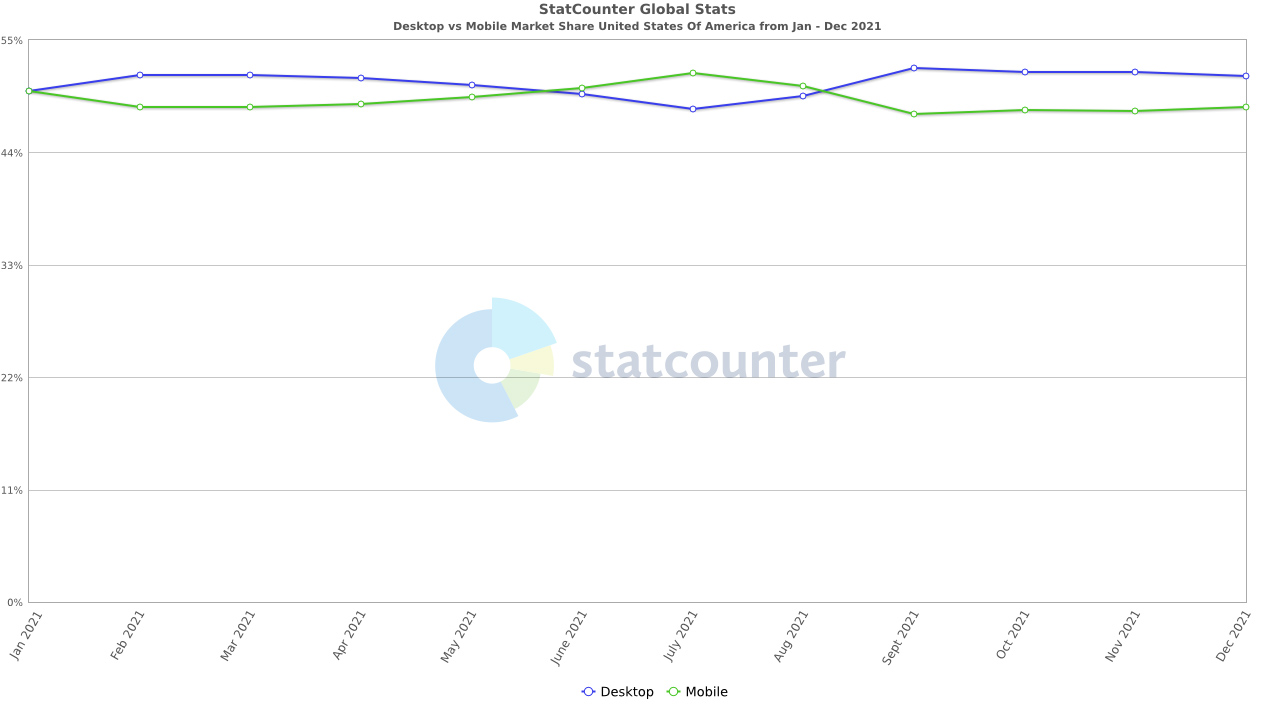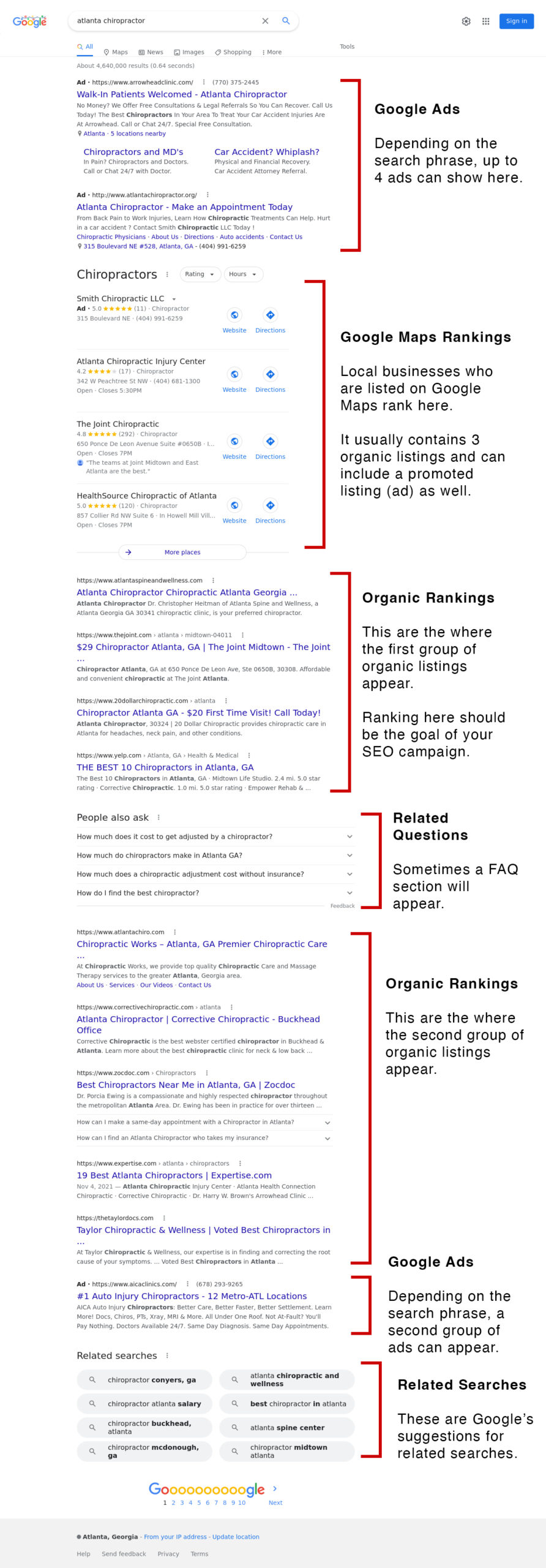
Now going into 2022, not only are mobile searches as common as desktop searches, for some sectors (such as Food and Beverage) mobile gets over 70% of overall searches.
What does this mean for marketing?
It shows that you have to have a holistic marketing strategy in place that will touch your prosepctive and existing customer base wherever they may be, whether on mobile or desktop devices.
This is especially important when it comes to your SEO and Paid Media campaigns with Google.

Analysis from StatCounter shows that searches from mobile devices are now averaging around the same as desktop searches.
It’s important to note that you shouldn’t treat mobile searches and desktop searches the same. The latest mobile usage statistics from Google show that timely and location based searches greatly skew towards mobile users while more in-depth research and less urgent searches happen on the computer.
Part of knowing how to target users, especially in search, is to know what they see when performing searches.
Below are examples of what users will see on a search engine results page (SERP) when doing a typical Google search from their smartphone or computer.
Example of a Desktop Search Result (SERP) on Google
Here’s a breakdown of a search results page on Google made from a desktop:
Google Ads
When available, Google will display up to four ads at the top of each search results page (SERP).
Google Maps Rankings
Local businesses who are listed on Google Maps (Google My Business) are ranked here. These rankings usually contain up to three organic listings but will occasionally include a sponsored listing (ad) as well.
Organic Rankings
Underneath the Google Maps’ section is usually where the first group of traditional organic listings appear.
Ranking here should be the goal of your SEO campaign.
Related Questions
The “People also ask” section is a group of questions Google deemed related to the search phrase you entered.
These questions can be a great insight for both searchers and content creators alike as they show relevant questions related to your search query and can help you save you time while looking for answers.
Organic Rankings
The second group of organic listings, and usually the largest, will appear next.
Google Ads
Depending on the search query, a second group of ads can appear.
Related Searches
This section contains Google’s suggestions for related searches. These are generated based on user data from search queries made before and/or after the current search phrase made.
If you’re comparing the layout of Google’s desktop search results from that of a few years ago, you’ll notice that most of the changes were to the design and not the elements that make up the page.
Most notably the ad label was updated to be less noticeable (was yellow before) and the ads on the right sidebar were removed in order to make the search results pages (SERPs) more in line with their mobile counterparts.
Example of a Mobile Search Result (SERP) on Google
Here’s a breakdown of a search results page on Google made from a smart phone:
Google Ads
In mobile search results, just like in desktop results, the sponsored listings (ads) dominate the top of the page.
These ads carry a lot of weight with smartphone users because not only do they show up first in Google’s search results, they sometimes contain call to action buttons, such as call buttons next to the listing.
Results Near [Location]
This section can vary where it’s displayed but its purpose is to show you the location Google is basing the search results on.
It also gives you the option to change the location in case you’re looking for different location-based results.
Google Maps Results
The Google Maps section (Local Pack) is mostly made up of organic listings and is heavily influenced by the user’s location.
From an SEO’s perspective, there are some things you can do to help rank here such as directory cleanup, review gathering and link building. So make sure your business is listed in Google My Business and make sure you’re getting lots of 5-star reviews.
Organic Results
King of the Mobile SEO Hill: Right after the map listings is the first organic search result. From an SEO’s point-of-view, this is the holy grail of positions to rank for in mobile search. Not only is it at the top, it’s free when users click it.
People Also Ask
FAQ: In some cases, Google will show this section in order to show related questions from users who were looking into the same topic as you are. This can be very helpful and help you expand your search. It can also be helpful from a publisher’s point-of-view as it shows what topics are surrounding a particular keyword and/or search phrase.
Organic Results
While not the greatest, this second group of organic results still get a fair amount of clicks so if you’re not ranking here continue to improve your SEO. Sometimes Google will expand your result with an image or navigation breadcrumb which will help your click-through-rate (CTR).
Refine This Search
Google will often show this section for local-based searches when they think you’ll benefit from a more detailed (long-tail) search phrase.
This can come in handy if you don’t know exactly what to search for so you start with a more general keyword and allow Google to give you more suggestions based on your topic.
Organic Results
Even though the majority of clicks on mobile searches takes places above this point, it is still very important to constantly improve your SEO so you can capture any remaining users scrolling down to find a suitable match .
Speaking of scrolling down, Google updated mobile search results to include a continuous scroll in order to allow users to continue “scrolling through a wider range of results may show you tons of options you hadn’t considered”.
This is great news for publishers and SEOs alike as it gives them the opportunity to rank on the first page of results for more keywords that they might not have been able to in the past.
Related Searches
These are Google suggestions for related searches. From a publisher’s point-of-view, these search terms (keywords) can help you can gauge how other local users search for content related to your local business and you can sometimes use them to find ways to reach out to customers.
Google Ads
Just like at the top of the search results page, Google will sometimes place up to four ads here as well. However, these ads tend to be less expensive than their top of the page counterparts.
While they may be at the bottom of the user’s scroll, sometimes they can grab users who have been hesitating to click or thinking about clicking while continuing to scroll downwards.
If they see a familiar site or are compelled by your ad copy, these users just might click. Make sure your tracking your Google Ads campaigns to make sure you know which ads are converting.
When comparing this layout to that of a few years ago, you’ll notice a lot of changes to not only the design, but to the elements that make up the mobile results page. Most notably, ads were given priority for what’s shown above the fold and the first organic result now is most often shown beneath the Google Maps results. The Google Maps results have also been limited to three organic listings with a promoted (ad) listing in there as well.
Those items, plus the additional features listed above have all been implemented since Google’s switch to mobile-first indexing back in 2019.
The Takeaway
Not only is mobile is here to stay, it has taken over in most circumstances and is only going to gain market share as time goes on. So it it very important to prepare your business websites and online presence in general for this surge of new mobile users. Things like making your site responsive to mobile devices, checking the functionality and UX on multiple devices, and verifying it is being crawled properly should be some of your first priorities in making sure your business is not only ready for mobile, but most likely mobile-first.
From a digital marketing perspective, targeting both desktop and smart phone users has a lot of overlap so there’s no need to throw out the playbook just yet and only need to make slight adjustments year-over-year as mobile continues to grow.
As far as search engine optimization and ranking goes, the results are essentially the same and only the layout and placement of the results will vary. You may however want to tell your SEO to count the mobile rankings as the priority vs desktop just in case there are some slight discrepencies for your industry related keywords.
The areas you would want to focus on if you are trying to target more mobile users would be the sponsored listings (Google Ads) and local SEO to improve your ranking in the Google Maps portion of search. These will help you with desktop searches as well, it is just that these two sections in particular take up a major part of the smart phone “screen real-estate” and tend to generate more clicks when viewed from a smart phone or mobile device.
If you need help with the switch over to mobile or need help with any of the services listed above, feel free to contact us and we will do our best to help you out.
Ryan Bradley
Latest posts by Ryan Bradley (see all)
- Desktop vs Mobile Search Results on Google - December 10, 2021
- How to Add Facebook Comments on WordPress Without Using A Plugin - September 26, 2020
- How to Implement HowTo Schema - May 14, 2020




